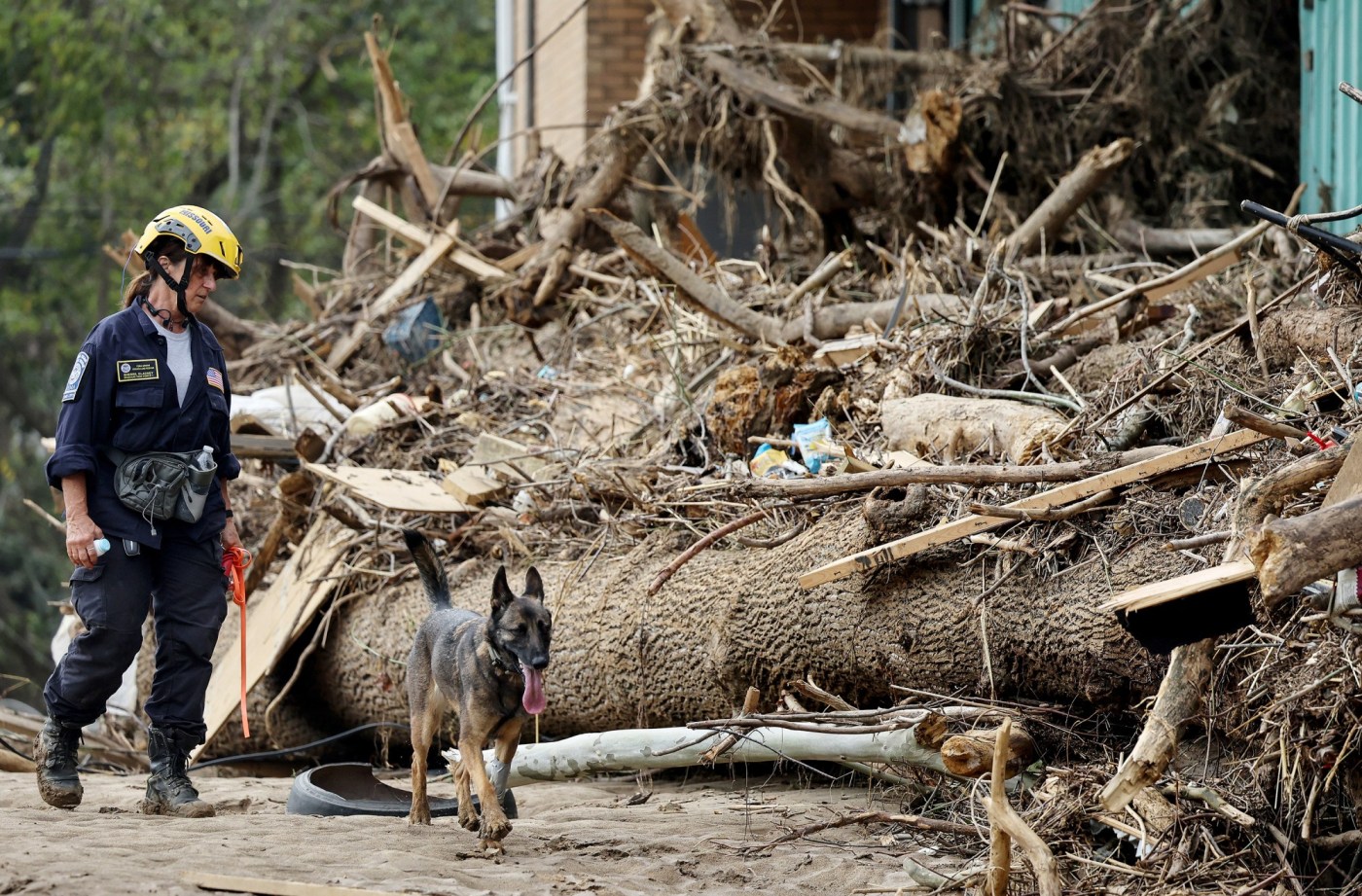
Analysis: Digging into FEMA spending claims on the campaign trail
WASHINGTON — Former President Donald Trump and some of his GOP allies on Capitol Hill have been falsely telling voters in key swing states that the Biden-Harris administration diverted more than $1 billion in disaster relief for Hurricane Helene survivors to feed and shelter undocumented immigrants.
Here’s Trump on his Truth Social platform Monday: “The GREAT people of North Carolina are being stood up by (Vice President Kamala) Harris and (President Joe) Biden, who are giving almost all of the FEMA money to Illegal Migrants in what is now considered to be the WORST rescue operation in the history of the U.S.”
But a history of the program shows policymakers on both sides of the aisle, including Trump, have cut spending deals that included a small slice of Federal Emergency Management Agency appropriations specifically to help states and localities care for migrants released into their communities, totaling just over $1.7 billion.
During that time, FEMA’s disaster relief fund has gotten several orders of magnitude more money, nearly $244 billion, and the two funding streams are entirely separate.
As Speaker Mike Johnson, R-La., who hasn’t joined the chorus of falsehoods in which some of his colleagues have engaged, put it in an interview with Fox News: “There are different programs that have different funding.”
The evolution of the agency’s funding, along with details about FEMA’s much larger disaster relief fund, point to how the complicated, behind-the-scenes nature of the federal appropriations process has fueled misleading talking points.
Reagan-era roots
While FEMA is best known for disaster relief, Congress appropriates more than $5 billion a year to the agency for other things, including a range of security-related grants for high-density urban areas, nonprofits, religious institutions, ports, Amtrak, bus stations, aid to local fire departments and more.
FEMA’s food and shelter program has its roots in the Reagan administration, expanded into migrant services during the Trump administration and Republican control of the Senate, and then got boosted by Biden and congressional Democrats as part of appropriations negotiations in 2022.
One of the smaller non-disaster programs began as part of an anti-recession package signed by President Ronald Reagan in 1983, containing $50 million for FEMA grants to charities and local governments to help alleviate hunger and homelessness.
The Emergency Food and Shelter Program stuck around and became a part of annual FEMA appropriations, receiving $117 million in fiscal 2024. The Biden administration requested $130 million for fiscal 2025, which House Republicans agreed to in their Homeland Security spending bill. Senate Democrats haven’t yet released their version.
Trump border request
A new innovation in FEMA’s food and shelter program emerged during the Trump administration in 2019.
Trump had requested a $4.5 billion emergency supplemental package to deal with the “humanitarian and security crisis at the southern border.” The largest piece was nearly $2.9 billion for the Department of Health and Human Services’ Office of Refugee Resettlement care for children who crossed the border unaccompanied by parents or guardians. There was no money for FEMA in the request.
Related Articles
As FEMA prepares for Hurricane Milton, it battles rumors surrounding Helene recovery
Biden and Netanyahu hold their first conversation in weeks. Trump recently called the Israeli leader
WATCH LIVE: Hurricane Milton webcams capture scene across Florida
Hurricane Milton’s outer bands reach Florida as millions of residents race to prepare — or flee the path
Today in History: October 9, Barack Obama wins Nobel Peace Prize
After two months of negotiations between the Democratic House, GOP Senate and Trump White House, Congress enacted a $4.6 billion package that kept the core funding for migrant children while making various additions and subtractions to other parts of the request.
One addition was $30 million, initially requested by the late Sen. Dianne Feinstein, D-Calif., for FEMA grants to local governments and nonprofits providing humanitarian aid to migrants.
The GOP-controlled Senate Appropriations Committee included the $30 million for what became known as the Emergency Food and Shelter Program-Humanitarian in its version of the border bill, which later passed the Senate on an 84-8 vote.
House Democrats unsuccessfully tried to double the FEMA allocation to $60 million, among other changes, and ultimately agreed to let the Senate bill come to the floor.
Only seven House Republicans voted against the bill, including current Reps. Andy Biggs and Paul Gosar of Arizona, Thomas Massie of Kentucky and Chip Roy of Texas. Trump signed it after a 305-102 House vote.
One big omission from Trump’s request was money to expand Immigration and Customs Enforcement detention capacity, and that led to other funding shuffles.
The Department of Homeland Security used “reprogramming and transfer” authorities provided in the fiscal 2019 DHS spending law to pull $116 million from various agency departments and use it for those ICE detention and removal activities.
At the same time, the department pulled $155 million from FEMA’s disaster relief fund to expand border courtroom facilities under Trump’s “Remain in Mexico” policy of requiring migrants to wait in Mexico while their asylum cases were adjudicated. FEMA at the time said there was plenty of money in the account and disaster relief efforts were unaffected.
Democrats sweep
After the 2020 elections, Democrats controlled the White House and both chambers of Congress.
They quickly cleared a $1.9 trillion pandemic relief package in early 2021, which contained another $110 million in Emergency Food and Shelter Program-Humanitarian funds. No Republicans backed that filibuster-proof budget reconciliation bill, which they viewed as too pricey with too many unrelated add-ons.
Regular fiscal 2022 appropriations were delayed thanks to months of squabbling over spending levels. Ultimately, in March 2022, lawmakers approved an omnibus package with another $150 million for the migrant food and shelter program.
In the House, 155 Republicans voted for the part of the package with DHS funding, which included money for the Defense Department and other sweeteners. A majority of Republicans voted against the rest of the bill, but there were enough Democratic votes to carry it. The combined measure cleared the Senate, 68-31, including support from 18 Republicans.
Republicans retake the House
Later in 2022, as border encounters were logging record highs, the House flipped to GOP control in the November elections.
Democrats had a final lame-duck opportunity to shape the annual appropriations outcome, and just before Christmas they cut a deal with Republicans on spending bills that included a new FEMA aid program for migrants.
In lieu of EFSP-H funding, Senate and House negotiators agreed to transfer $800 million from Customs and Border Protection appropriations to FEMA “to support CBP in effectively managing noncitizen processing and preventing the overcrowding of short-term CBP holding facilities,” the report accompanying the fiscal 2023 omnibus said.
On final passage, only nine House Republicans supported the omnibus package, while 18 Senate Republicans did in their chamber.
After Republicans settled in as the new majority in 2023, they sought to kill any funding for the new Shelter and Services Program or its predecessor in the fiscal 2024 DHS bill. Senate Democrats’ version included a $752 million CBP transfer to FEMA.
Spending negotiations again dragged out into the new calendar year, resulting in another March deal on funding for DHS and the rest of the federal government. The DHS agreement was the hardest-fought and almost didn’t happen amid numerous policy and funding disputes.
The final accord resulted in a $650 million CPB transfer to FEMA for the Shelter and Services Program. Republicans claimed victory on the $150 million annual cut, while Democrats celebrated the program’s survival. On the final House vote, which again was on a broader package that included the Defense Department and other agencies, 101 Republicans supported it.
In their fiscal 2025 bill, House Republicans again are proposing to zero out the program, which Democrats are again fighting. That will be hammered out sometime after the elections, along with the rest of this year’s full-year appropriations.
Before they get to that stage, some Republicans, including Arkansas Sen. Tom Cotton on “Meet the Press” on Sunday, argue that FEMA should use transfer authority to move any remaining Shelter and Service Program funds over to disaster relief. But that’s likely to be difficult since FEMA already awarded all the fiscal 2024 SSP grant money by the end of August.
Disaster relief fund
By far the largest part of FEMA’s annual budget is disaster aid, which in fiscal 2024 totaled $36.3 billion — nearly 56 times the amount set aside for migrant shelter and services that year.
So far, the agency has received nearly $20.3 billion in fiscal 2025, an amount congressional leaders say is certain to grow when lawmakers reconvene after the elections.
The current expectation is existing funds will be exhausted by January, and that’s before Hurricane Milton, currently a Category 4 storm predicted to make landfall in Florida on Wednesday, or any other named storms in the final months of hurricane season.
Even if no other major disasters hit between now and year-end, FEMA is still expected to burn through more than $200 million a day on average.That means even if Congress had appropriated the full $650 million fiscal 2024 Shelter and Services Program amount instead for FEMA, it would buy the disaster aid fund only about three days of breathing room.
Overall, between fiscal years 2019 and 2025, the disaster relief fund so far has received about $243.8 billion, including $97 billion for pandemic-related needs. That compares with a little over $1.7 billion for FEMA migrant services grants since their fiscal 2019 inception.
So, during the period starting when Trump signed the first allotment for EFSP-H into law, Congress has appropriated about 140 times that amount for FEMA disaster relief.
©2024 CQ-Roll Call, Inc., All Rights Reserved. Visit cqrollcall.com. Distributed by Tribune Content Agency, LLC.


